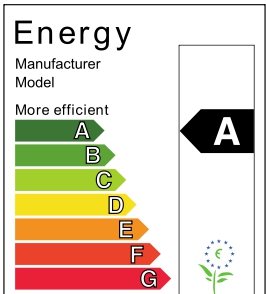Express Doors Direct ▸ Blog ▸ What is U-Value and How Does it Relate to My Doors?
Last updated on January 25th, 2022 at 10:51 am
Among the most important attributes of any set of doors, besides the way that it looks, is its thermal efficiency. This is the degree to which it prevents heat from passing to one side to the other. If your doors are thermally efficient, then they’ll keep the warmth within your home. If they aren’t, then they’ll conduct that heat into the exterior, and you’ll need to spend more on heating the interior up again. As such, energy-efficient doors are an investment that will pay off in the long-run.
Thermal efficiency can be quantified using something called a U-value. This is a figure which describes the insulating performance of a set of doors and windows. In this article, we’ll delve a little into the wonderful world of U-values, and see how paying attention to them can inform a better buying decision, and ultimately save you money on your energy bills in the long-run. Let’s get started!
What Does U-value Mean?

So let’s define exactly what it is we’re talking about. What is a u-value, and why is it important? And is a higher or lower U-value better?
The u-value of a surface refers to its ability to transmit heat. It’s measured in watts per square metre Kelvin. The lower the number, the less energy will be transmitted from one side of any square-metre portion of the door in a given amount of time.
What Is The Best U-value?
A high-quality set of external doors, complete with double-glazing, will have a U-value of around 1.6. If you’re willing to invest a little more, then you’ll find that this number can fall down even further. For comparison, an insulated cavity wall can offer a U-value of around 0.5.
You can work out the u-value of a surface yourself, but it’s easy to find online calculators that’ll do the job for you. Remember that the u-value doesn’t account for the size of the door – so, if you’re considering two doors of similar U-value, one of which is markedly larger than the other, then you’ll probably find that the two differ in their thermal performance.
For most of us, this stuff is a little on the technical side. But fortunately, understanding U-values in this way isn’t essential. You don’t need to know what U-value means in order to compare one set of doors to another: you just need to remember that lower is better!
U-value for Doors: What Do I Need to Know?

The U-value of a door is influenced by a myriad of different factors, including the materials used and the thickness of the door. Let’s think about a few of them.
The best u-value front door is one that’s made from a combination of different materials. A composite door might come with an outer veneer of wood, or of uPVC that’s been shaped to look like wood. The interior of the door is made from a combination of metal and plastic. They’re substantial and energy-efficient.
Aluminium U-value
A solid steel door is naturally very inefficient, as the metal conducts heat easily.
In practice, aluminium frames are more common – and since this material is stronger and lighter, the frames can be made much thinner. This means more glass and, in theory, less energy being transmitted overall.
Solid Wood U-value
A solid oak door has a U-value of around 3, depending on its thickness. This is because heat has a far easier time passing through oak than it does plastic. This is why the overwhelming majority of newer houses come with uPVC doors installed instead. Owners of oak external doors can either look to limit the damage by installing seals, draught excluders, and letter-box insulation, or they can get rid of the whole thing in favour of a composite door. Modern composite doors are able to convincingly mimic the look of wood and offer far superior energy performance, which makes them well worth considering if heat-preservation is a priority.
What does the Law Say?
In 2010, a change in building regulations meant that all new doors had to have a U-value of 1.8W/M2K or less. However, this only applies when the work being carried out is a controlled fitting – which in practice means that the entire frame is being replaced along with the door. As such, if you’re only replacing the door itself, then you might well be able to get away with a less energy-efficient door. Of course, you’ll then have the disadvantage of higher energy bills – but this might be a sacrifice you’re willing to make.
What About the BRFC Ratings?
The U-value of a door is distinct from its BRFC rating, which comes on a lettered scale from A++ to G. These ratings provide an intuitive, at-a-glance indication of how well a door will retain heat. It takes into account things that have nothing to do with U-value, like the amount of heat gained through sunlight, and draughtiness.
U-Values in Sliding Glass Doors
A good illustration of this comes in the distinction between sliding and French doors. The former need to move across one another, and therefore can’t come with compressible seals. This allows air to more easily move from one side of the door to the other, and it’ll take the heat with it as it does so. But the U-value of the panels themselves might be identical. As such, U-value isn’t the be-all and end-all of thermal performance in doors.
With that said, the number does provide a way of comparing similar doors to one another – and it’s a figure you should bear in mind when you’re shopping for a new set of doors.
Before we sign off, let’s note that an external door represents just a very small portion of the overall surface of a property. The difference between a very-efficient uPVC door and a not-so-efficient wooden one might therefore not be worth putting up with the downsides of the former. In other words, if you really don’t like the look or feel of a certain style of door, then maybe think twice before investing in it on pure energy-efficiency grounds!
Related Posts:
"It is about the realities of what makes for an attractive, civilized, meaningful environment, not about fashion or what's in or what's out. This is not an easy job."
– Albert Hadley
Available in a range of sizes, designs and colours with a #MadeToMeasureDoors service available too.
Email [email protected] to book in for 2024.
Featured Posts
Recent Posts

Blending Old and New: Internal Cottage Doors for a Modern Farmhouse Look

Kitchen Doors and Bathroom Doors: How to Shop and What’s in Style Now

Glazed Internal Doors: Let the Light in for Summertime – and beyond!

Wall Panelling Ideas: Unexpected Benefits and the Latest Trends

Pocket Doors vs Bifold Doors: The Pros and Cons





























































